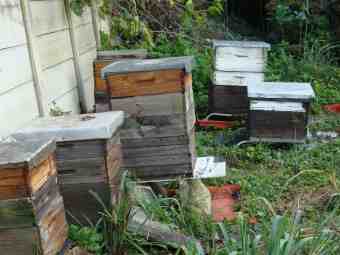- Bernard Preston homepage
- Beekeeping
- Bird Pressure on Hive Productivity
Bird pressure on hive productivity
Bird pressure on hive productivity can certainly be significant; 300 bees per day.
I notice that we have a diversity of insect-eating birds that congregate
around our hives in the morning. Do you think that the swarms are large
enough to sustain the losses from these drongos; what sort of impact
will they have on honey production?
My sense is that it could be negligible and that we should allow them to take the bees they can, especially as they do not hang around the hives all day. What are your thoughts?
It's an interesting question; and I would like others to contribute to
this topic. The bird in question is I presume the fork tailed bee-eater,
or drongo. Each one can apparently take up to 300 per day; that is
a considerable threat to the colony.
Each bee will collect about a teaspoon of honey in her life time; it's a significant threat. It means that each drongo could cost you up to three 500 gram bottles per day; value about R300.
The problem looking at the bigger picture is that the drongo makes a
great contribution to keeping other insects under control; they are an
important part of the ecological cycle.
They are highly
intelligent birds, not easily frightened off; and I for one will not
shoot them, despite the significant damage they do to our hives.
I keep a paintball gun which I fire off, aiming to hit the branch they are sitting on but not the bird. That does frighten them off but they revert when your back is turned. It's mainly a problem in misty weather, early in the morning and the late afternoon; when there is little activity.
When there are large numbers of bees flying they will attack a drongo; so the birds stay away.
It's a nuggety problem; I wonder what others think?
Bird pressure on hive productivity

Bird pressure on hive productivity is a worry as a drongo can take up to 300 bees per day apparently.
When browsing use right click and "Open Link in New Tab" or you may get a bad gateway signal.
Newsletter
Our newsletter is entitled "create a cyan zone" at your home, preserving both yourself and Mother Earth for future generations; and the family too, of course. We promise not to spam you with daily emails promoting various products. You may get an occasional nudge to buy one of my books.
Here are the back issues.
- Lifestyle and ideal body weight
- What are ultra-processed foods?
- Investing in long-term health
- Diseases from plastic exposure
- Intensive lifestyle management for obesity has limited value
- A world largely devoid of Parkinson's Disease
- The impact of friendly bacteria in the tum on the prevention of cancer
- There's a hole in the bucket
- Everyone is talking about weight loss drugs
- Pull the sweet tooth
- If you suffer from heartburn plant a susu
- Refined maize meal and stunting
- Should agriculture and industry get priority for water and electricity?
- Nature is calling
- Mill your own flour
- Bake your own sourdough bread
- Microplastics from our water
- Alternative types of water storage
- Wear your clothes out
- Comfort foods
- Create a bee-friendly environment
- Go to bed slightly hungry
- Keep bees
- Blue zone folk are religious
- Reduce plastic waste
- Family is important
- What can go in compost?
- Grow broad beans for longevity
- Harvest and store sunshine
- Blue zone exercise
- Harvest and store your rainwater
- Create a cyan zone at your home
Did you find this page interesting? How about forwarding it to a friendly book or food junkie? Better still, a social media tick would help.
- Bernard Preston homepage
- Beekeeping
- Bird Pressure on Hive Productivity
Address:
56 Groenekloof Rd,
Hilton, KZN
South Africa
Website:
https://www.bernard-preston.com
